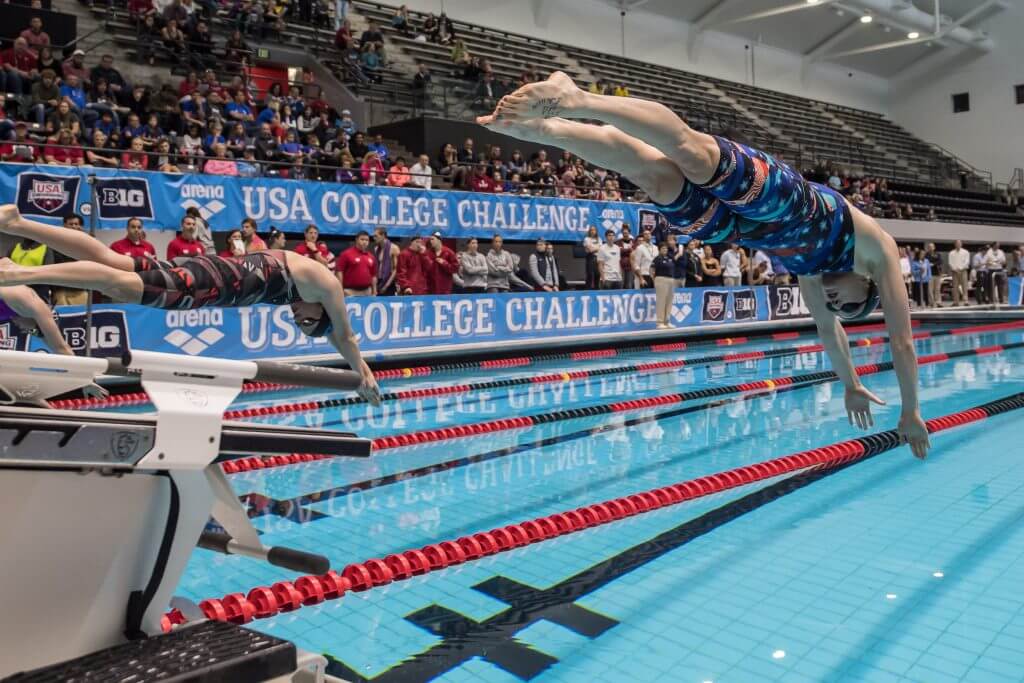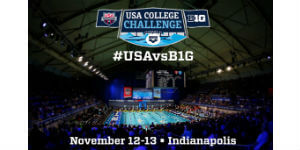Despite Blowout Score, USA College Challenge Proves Its Worth

By David Rieder.
This past weekend, three months after the Olympic Games, USA Swimming reintroduced itself to the college dual meet.
No, the USA College Challenge was not the first time the U.S. National team had taken on college foes head-to-head. It had just been a while.
“In the fall of 1993, we had these dual meets,” USA Swimming Assistant Executive Director Mike Unger said. “We would send 10 men and 10 women to go swim Auburn one day and Alabama the next day. Put them in a van and send a manager and a coach with them. And the next year we did Arizona and Arizona State.”
And then in the fall of 1998, USA Swimming faced off against a group of Big Ten All-Stars in a dual meet at Northwestern. 18 years later, the concept was resurrected in the form of the USA College Challenge, held Saturday and Sunday at the IUPUI Natatorium in Indianapolis.
A team of Americans ranging in age from 15 to 30 took on an Olympian-laden Big Ten squad. American Olympians Lilly King, Blake Pieroni, Cierra Runge and Jordan Wilimovsky and international Olympians Kennedy Goss, Siobhan Haughey, Shane Ryan and Kierra Smith all represented their conference.
Even with more than three-quarters of the U.S. Olympic team absent—most of them retired, on a post-Olympics break or busy competing for an NCAA team outside of the Big Ten—the meet was largely non-competitive in the team scoring department as the U.S. roster crushed the Big Ten, 349 to 247.
Of course, it’s not as though Team USA has typically been challenged in its dual meets.
Many fans will remember the Duel in the Pool, which pitted the U.S. against Australia in 2003, 2005 and 2007 and then against a group of European All-Stars in 2009, 2011, 2013 and 2015. Combined, those seven meets produced one competitive showdown in four tries. That came in Glasgow in 2013, when the Americans came from behind to the European team in the last relay and then won the meet in a winner-take-all mixed 200 medley relay.
After yet another blowout in the USA College Challenge, some might be quick to write the new format off as a bust. But not so fast.
Try telling Ali DeLoof, Andrea Cottrell, Kelsi Worrell and Amanda Weir that the meet was a waste of time. (They would likely disagree.) In the first event, that foursome won the women’s 400 medley relay in 3:25.60, a new American record—for DeLoof and Cottrell, the first of their respective careers.
DeLoof moved to eighth all-time in the 100 back with her 50.59 leadoff split—after never making the A-final in the event at the NCAA championships during her four-year career at Michigan. She made an impression this summer at Olympic Trials when she finished fourth in the 100 back in 59.69, and now it looks like that may have been just the beginning.
In the first individual event of the meet, 17-year-old Brooke Forde took the win in the women’s 400 IM in 4:02.67. Fresh off a trip to the World Cup with the National Junior team, the Stanford commit posted a time that would have placed second at last year’s NCAA championships and actually took down two women who swam in that final, Minnesota’s Brooke Zeiger and Ohio State’s Lindsey Clary.
Mallory Comerford made her National Team debut with a win in the 100 free in 47.36, a lifetime best and the top time in the country this year, and another high schooler picked up an event victory as Eva Merrell dropped five seconds to win the 200 back in 1:52.20.
Day two of the meet saw highly-touted teen Michael Andrew take down veterans Cody Miller and Nic Fink to win the men’s 100 breast in a quick 51.90, followed up by a win in the 200 IM (1:44.20). And in the final women’s individual event, 15-year-old Alex Walsh won the women’s 200 IM in 1:55.89, another time that would have made last year’s NCAA final.
It’s worth reiterating that Walsh is 15 and a freshman in high school, plus she’s arguably an even better backstroker than IMer.
How about Zane Grothe, who suffered one of the biggest heartbreaks of Olympic Trials when he finished fifth in the 400 free after qualifying first out of prelims, bouncing back with two wins at the College Challenge? He earned tight victories in both the 500 (4:15.87) and 1000 free (8:46.22) and then, after only a few minutes’ rest post-1000, finished second in the 200 free in 1:34.83.
Even one of the few U.S. Olympians on the roster showed major signs of growth. Blake Pieroni surprised many when he made his way onto the Rio-bound squad with a sixth-place finish in the 100 free at Olympic Trials, but he has shown new life in his return to Indiana for his junior season. At the College Challenge, Pieroni dominated both the 100 (42.40) and 200 free (1:33.43).
It’s impossible to know for sure how the dual meet format affected each athlete, but do not underestimate the impact of competing in such a high-intensity yet low-pressure environment.
“You had kids dropping times left and right,” Unger said. “When we go to the World Championships and Olympic Games, it clearly is a team, you are an individual swimming. When you put the points up there, it changes things. People step up in different ways.”
Sure, the final score was a blowout, but that’s by no means a rare occurrence at a college dual meet. And invisible in the scores are the excitement of the down-to-the-wire finishes between Grothe and Wilimovsky in the men’s 1000, Merrell and Goss in the women’s 200 back, King and Smith in the women’s 200 breast. Four years after the post-Olympic Minnesota Grand Prix on the same weekend drew a sparse crowd of athletes, the College Challenge proved a massive upgrade.
USA Swimming tentatively plans to bring back the meet in future years, and athlete attendance will seemingly correct itself as veterans return from their post-Olympics layoffs. The stakes will surely ratchet up with more decorated résumés in the building and likely attract some larger crowds, and other NCAA conferences could be brought into the mix
“The initial plan was to go SEC in ’17 and Pac-12 in ’18, but we’ve already had some people from the Pac-12 say, ‘We want it next year!’” Unger said.
These dual meets are fun events for both swimmers and fans, the American swim team will only be judged long-term by performances on the international stage—specifically at the Olympic Games. How can an event like the College Challenge help towards that cause?
Simple: confidence. If Comerford or Forde or Merrell or even Andrew left Indianapolis more confident about their sense of belonging on a National team roster, it was worth it. Because undoubtedly those four and plenty of the Challenge’s other top performers will have plenty to say about the composition of international rosters in the next year and beyond.
All commentaries are the opinion of the author and do not necessarily reflect the views of Swimming World Magazine nor its staff.





Nonsense. It may have been fine from the athletes point of view, but the 200 spectators in the stands, and the B10 network dropping multiple events to put on a college football talk show says it all. There were good swims no question, but many bad swims from no names on both sides which made the event hard to follow. Add the blowout score to the aforementioned and USA Swimming has a bust.
Disagree. I view this meet as a work in progress. It was a great first step.